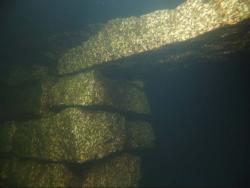INSTITUT SUPERIEUR D'ANTHROPOLOGIE
INSTITUTE OF ANTHROPOLOGY
ONLINE COURSES / COURS A DISTANCE
SPRING TERM : APRIL 2018
REGISTER NOW
USA –  York - Last week's destructive nor'easter, which slammed New England's coast with powerful winds and fierce waves, unearthed the remnants of a Revolutionary War-era shipwreck along Short Sands Beach in York, Maine. While all that remains of the vessel is the ship's deteriorated skeleton and ribbing, it is a rare spectacle for beachgoers as it is usually buried beneath several feet of sand."The vessel, most likely a sailing ship from anywhere between 1750 and 1850, is usually buried in the sand at Short Sands Beach, but has appeared a handful of times after stormy weather uncovered it," archaeologist Leith Smith told the Boston Globe. After much discussion and a meeting with archaeologists and York residents, many concluded that the remnants were from a type of fishing vessel known as a pincke, or a pink, the report said."Boats of this type had a high, narrow stern and square rigging. They were easily maneuverable along the rocky coast of Maine and were a popular fishing and cargo vessel during the 18th century," Seacoastonline reported.
York - Last week's destructive nor'easter, which slammed New England's coast with powerful winds and fierce waves, unearthed the remnants of a Revolutionary War-era shipwreck along Short Sands Beach in York, Maine. While all that remains of the vessel is the ship's deteriorated skeleton and ribbing, it is a rare spectacle for beachgoers as it is usually buried beneath several feet of sand."The vessel, most likely a sailing ship from anywhere between 1750 and 1850, is usually buried in the sand at Short Sands Beach, but has appeared a handful of times after stormy weather uncovered it," archaeologist Leith Smith told the Boston Globe. After much discussion and a meeting with archaeologists and York residents, many concluded that the remnants were from a type of fishing vessel known as a pincke, or a pink, the report said."Boats of this type had a high, narrow stern and square rigging. They were easily maneuverable along the rocky coast of Maine and were a popular fishing and cargo vessel during the 18th century," Seacoastonline reported.
https://www.accuweather.com/en/weather-news/noreaster-unearths-revolutionary-war-era-shipwreck-on-maine-shoreline/70004352
ROYAUME UNI –  Penryn - The Cornwall Marine Archaeology divers photographed the rusting remains beneath the surface of the flooded Little Trolvis Quarry, near Longdowns, Penryn. Fascinating pictures have been taken by divers of the eerie remains of machinery and a submerged granite building nearly 60ft below the surface of a flooded quarry.Among the rusting remains on the floor of the quarry was an old wheel, pipework and the haunting outline a building believed to be an old forge. Inside the team found the heavily corroded remains of a vice which was still in place.
Penryn - The Cornwall Marine Archaeology divers photographed the rusting remains beneath the surface of the flooded Little Trolvis Quarry, near Longdowns, Penryn. Fascinating pictures have been taken by divers of the eerie remains of machinery and a submerged granite building nearly 60ft below the surface of a flooded quarry.Among the rusting remains on the floor of the quarry was an old wheel, pipework and the haunting outline a building believed to be an old forge. Inside the team found the heavily corroded remains of a vice which was still in place.
https://www.cornwalllive.com/news/cornwall-news/remains-lost-forge-60-feet-1313759
ISRAEL –  Negev - The discovery of a large quantity of bones belonging to Tristram’s jird, a common gerbil-like rodent in Israel, has provided Israeli researchers with the first biological evidence of the northern Negev’s flourishing agriculture some 1,500 years ago. The bones were discovered in ancient fields tended by Byzantine farmers during a period when the area was much greener than it is today.“We have found bones of this rodent dating back to the Byzantine period in areas that are currently arid and do not offer the habitat it requires. The findings show that Byzantine agriculture was so well-developed that it had an impact on species diversity in the Negev,” explained Prof. Gur Bar-Oz of the University of Haifa, who is heading a study researching the collapse of Byzantine cities of the Negev.While archeological evidence and ancient historical texts had led scientists to conclude there was extensive agriculture in the region, no biological evidence was found until now. The current study is being conducted by research student Tal Fried, together with Lior Weissbrod, Yotam Tepper, and Prof. Guy Bar-Oz from the University of Haifa’s Institute of Archaeology. Findings from their research, including the rodent bones, were published in the Journal of the Royal Society of the British Academy of Sciences.
Negev - The discovery of a large quantity of bones belonging to Tristram’s jird, a common gerbil-like rodent in Israel, has provided Israeli researchers with the first biological evidence of the northern Negev’s flourishing agriculture some 1,500 years ago. The bones were discovered in ancient fields tended by Byzantine farmers during a period when the area was much greener than it is today.“We have found bones of this rodent dating back to the Byzantine period in areas that are currently arid and do not offer the habitat it requires. The findings show that Byzantine agriculture was so well-developed that it had an impact on species diversity in the Negev,” explained Prof. Gur Bar-Oz of the University of Haifa, who is heading a study researching the collapse of Byzantine cities of the Negev.While archeological evidence and ancient historical texts had led scientists to conclude there was extensive agriculture in the region, no biological evidence was found until now. The current study is being conducted by research student Tal Fried, together with Lior Weissbrod, Yotam Tepper, and Prof. Guy Bar-Oz from the University of Haifa’s Institute of Archaeology. Findings from their research, including the rodent bones, were published in the Journal of the Royal Society of the British Academy of Sciences.
https://www.israel21c.org/rodent-bone-discovery-provides-signs-of-ancient-farming/